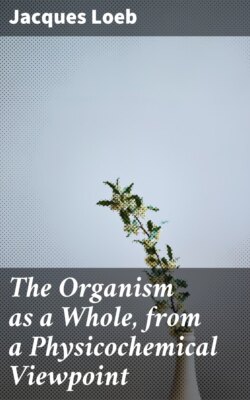Читать книгу The Organism as a Whole, from a Physicochemical Viewpoint - Jacques Loeb - Страница 10
На сайте Литреса книга снята с продажи.
THE CHEMICAL BASIS OF GENUS AND SPECIES
ОглавлениеTable of Contents
1. It is a truism that from an egg of a species an organism of this species only and of no other will arise. It is also a truism that the so-called protoplasm of an egg does not differ much from that of eggs of other species when looked at through a microscope. The question arises: What determines the species of the future organism? Is it a structure or a specific chemical or groups of chemicals? In a later chapter we shall show that the egg has a simple though definite structure, but in this chapter we shall see that the egg must contain specific substances and that these substances which determine the “species” and specificity in general are in all probability proteins. Since solutions of different proteins look alike under a microscope we need not wonder that it is impossible to discriminate microscopically between the protoplasm of different eggs.
The idea of definiteness and constancy of species, a matter of daily observation in the case of man and higher animals in general, was not so readily accepted in the case of the micro-organisms, which on account of their minuteness and simplicity of structure are not so easy to differentiate. There existed for a long time serious doubt whether or not the simplest organisms, the bacteria, possessed a definite “specificity” like the higher organisms, or whether they were not endowed, as Warming put it, with an “unlimited plasticity,” which forbade classifying them according to their form into definite species as Cohn had done. An interesting episode in this discussion, which was settled about twenty-five years ago arose concerning the sulphur bacteria, which often develop in large masses on parts of decaying plants or animals along the shore. Sir E. Ray Lankester found collections of red bacteria covering putrefying animal matter in a vessel and forming a continuous membrane along its wall. These red bacteria were of very different shape, size, and grouping, but they seemed to be connected by transition forms. They had a common character, however, namely, their peach-coloured appearance. This common character, together with their association in the same habitat, led Lankester to the then justifiable belief that they all belonged to one species which was protean in character and that the different forms were only to be considered as phases of growth of this one species. The presence of the same red pigment “Bacterio-purpurin” seemed justly to indicate the existence of common chemical processes. Cohn, on the contrary, considered the different forms among these red bacteria (they are today called sulphur bacteria since they oxidize the hydrogen sulphide produced by bacteria of putrefaction to sulphur and sulphates) as definite and distinct species, in spite of their common colour and their association. Later observations showed that Cohn was right. Winogradsky30 succeeded in proving by pure culture experiments that each of these different forms of sulphur bacteria was specific and did not give rise to any of the other forms of the same colour found in the same conditions.
The method of pure line breeding inaugurated by Johannsen31 has shown that the degree of definiteness goes so far that apparently identical forms with only slight differences in size may breed true to this size; but for reasons which will become clear later on we may doubt whether they are to be considered as definite species.
The fact of specificity is supported by the fact of constancy of forms. de Vries has pointed out that regardless of the possible origin of new species by mutation the old species may persevere. Walcott has found fossils of annelids, snails, crustaceans, and algæ in a precambrian formation in British Columbia whose age (estimated on the rate of formation of radium from uranium) may be about two hundred million years and estimated on the basis of sedimentation sixty million years. And yet these invertebrates are so closely related to the forms existing today that the systematists have no difficulty in finding the genus among the modern forms into which each of these organisms belongs. W. M. Wheeler, in his investigations of the ants enclosed in amber, was able to identify some of them with forms living today, though the ants observed in the amber must have been two million years old. The constancy of species, i.e., the permanence of specificity may therefore be considered as established as far back as two or possibly two hundred millions of years. The definiteness and constancy of each species must be determined by something equally definite and constant in the egg, since in the latter the species is already fixed irrevocably.
We shall show first that species if sufficiently separated are generally incompatible with each other and that any attempt at fusing or mixing them by grafting or cross-fertilizing is futile. In the second part of the chapter we shall take up the facts which seem destined to give a direct answer to the question as to the cause of specificity. It is needless to say that this latter question is of paramount importance for the problem of evolution, as well as for that of the constitution of living matter.
